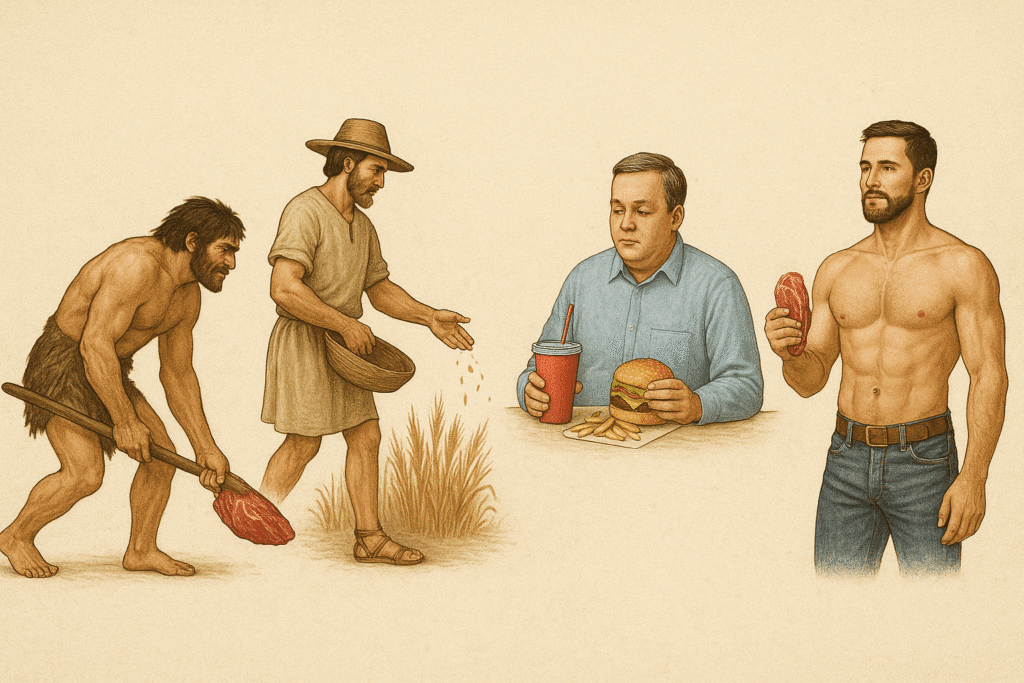What if everything we thought we knew about healthy eating is wrong? This deep dive uncovers the surprising truth about how humans are really meant to eat—from raw liver to seed oil science—and why going back to our roots might be the healthiest move we ever make.
What If the Food Pyramid Was Built Upside Down?
Here’s a wild idea: what if we’re not broken, lazy, or unlucky when it comes to our health—but simply eating the wrong food for our biology?
If you’ve ever felt worse eating “healthy,” you’re not alone. I’ve been there—counting calories, fearing fat, chewing endless salads—only to feel bloated, tired, and honestly, just off. Turns out, we might’ve taken a massive wrong turn. The good news? We can walk it back. Let’s dig into what humans actually used to eat… and why it still matters.
How Our Ancestors Really Ate (Hint: It Wasn’t Oat Milk & Kale)

If we go back far enough—like 2.5 million years—humans weren’t farming, fermenting, or shopping for fiber-rich superfoods. We were hunting. We thrived on meat, fat, and organs. Not occasionally. Not as a side. As the main course—every single day.
And this isn’t just guesswork. Anthropologists have found:
- Prehistoric skeletons with bone chemistry richer in meat than actual carnivores (1)
- Tools used to butcher animals long before we had fire for cooking
- Signs that eating fatty animals may have literally grown our brains
That’s not me romanticizing caveman life. That’s just science.
Then Came Grains… and the First Health Crash
Around 10,000 years ago, the agricultural revolution kicked off. People settled down. We grew wheat, rice, corn. Sounds nice in theory—until you look at what happened to our bodies.
- We shrank. Literally. Height dropped.
- Tooth decay skyrocketed
- We started seeing more nutritional deficiencies and bone issues
Grains might’ve fed more people, but they came with a price:
- Phytates and lectins—compounds in plants—block mineral absorption (2)
- Gut inflammation increased
- Digestive issues became more common
Our bodies weren’t built for this kind of diet shift—and it shows.
Modern Diet = Modern Disease
Let’s fast forward to the last 100 years. Most of us are now eating foods our great-grandparents wouldn’t recognize. Think seed oils, fake meats, sugar in everything, and boxes that say “heart healthy” but leave you bloated and foggy.
It’s not your fault. The system taught us to fear the wrong things.
Here’s what we now know:
- Seed oils like canola and soybean oil are loaded with unstable omega-6s
- These fats oxidize easily, trigger inflammation, and have been linked to heart disease and metabolic dysfunction (4, 5)
- Sugar and refined carbs mess with blood sugar, mood, and energy like clockwork
And somehow, red meat and butter got the blame? Make it make sense.
Paleo and Carnivore Aren’t Trends—They’re Returns to Home Base
Over the past few years, I started dialing back the dogma and just eating real, whole, nutrient-rich food—mainly from animals. I noticed something wild: I started feeling like myself again. Less bloated. Better skin. Clearer thinking. And I’m not alone.
Millions are discovering the power of:
- Grass-fed meat and wild seafood
- Organs like liver, heart, and kidney
- Animal fats like tallow, suet, and marrow
No, it’s not restrictive. It’s freeing. It’s going back to what worked for almost all of human history.
Final Thoughts: Maybe It Was Never the Meat
Look, I get it. We’ve been taught to fear fat, to count calories, to load up on whole grains. But if that was really the path to health, wouldn’t we all be thriving by now?
Here’s what I believe:
– We’re not sick because we ate too much meat.
– We’re sick because we stopped eating it.
So if you’re tired of feeling tired, of bloating, cravings, or random symptoms your doctor brushes off—it’s not in your head. It might be on your plate. And there’s a way out.
Start simple. Eat real food. Eat food that could’ve existed 100,000 years ago. Your body knows what to do from there.
SOURCES & FURTHER READING:
- Richards, M. P., et al. (2000). Neanderthal Diets. PNAS.
- Lönnerdal, B. (2000). Phytates & Mineral Absorption.
- Cohen, M. N. (1989). Health and the Rise of Civilization.
- Ramsden, C. E., et al. (2013). BMJ – Seed Oil Heart Disease Link.
- DiNicolantonio, J. J., & O’Keefe, J. H. (2018). Open Heart – Oxidized Fats.
Leave a Reply